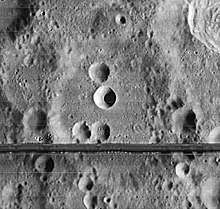Rabbi Levi (crater)
Rabbi Levi is a lunar impact crater that is located among the rugged highlands in the southeastern part of the Moon's near side. Several notable craters are located nearby, including Zagut just to the north-northwest, the heavily impacted Riccius to the southeast, and Lindenau to the northeast next to Zagut.
 Lunar Orbiter 4 image, the thick black line is an artifact | |
| Coordinates | 34.7°S 23.6°E |
|---|---|
| Diameter | 81 km |
| Depth | 3.5 km |
| Colongitude | 336° at sunrise |
| Eponym | Levi ben Gershon |
This is a heavily worn and eroded crater formation, with several smaller craters lying along the incised rim and across the interior floor. A group of these craters form a cluster in the western part of the floor, consisting of the satellite craters A, L, M, and D, as well as lesser craterlets trailing away to the south-southeast. The largest of these craters is Rabbi Levi L, a bowl-shaped formation just to the northwest of the midpoint. The remainder of the floor is relatively level and nearly featureless. Clusters of craters also lay across the eastern and southwestern sections of the rim.
Attached to the northeast is the remnant of an old formation that intrudes into Rabbi Levi, producing a straightened section of rim along that face. This unnamed formation has been almost completely obliterated, and is overlain in the northwest by Lindenau, and along the outer northeast side by Rothmann.
The crater is named after the Medieval French Jewish scholar Levi ben Gershon, better known by his Graecized name as Gersonides.
Satellite craters
By convention these features are identified on lunar maps by placing the letter on the side of the crater midpoint that is closest to Rabbi Levi.
| Rabbi Levi |
Latitude | Longitude | Diameter |
|---|---|---|---|
| A | 34.3° S | 22.7° E | 12 km |
| B | 34.5° S | 24.8° E | 13 km |
| C | 34.3° S | 27.0° E | 20 km |
| D | 35.4° S | 22.8° E | 10 km |
| E | 36.7° S | 22.1° E | 35 km |
| F | 36.0° S | 20.5° E | 12 km |
| G | 36.9° S | 22.0° E | 12 km |
| H | 36.4° S | 20.2° E | 8 km |
| J | 37.6° S | 22.7° E | 7 km |
| L | 34.7° S | 23.0° E | 13 km |
| M | 35.2° S | 23.2° E | 11 km |
| N | 36.4° S | 23.7° E | 8 km |
| O | 35.7° S | 25.1° E | 7 km |
| P | 34.5° S | 25.8° E | 15 km |
| Q | 33.7° S | 25.8° E | 6 km |
| R | 33.6° S | 28.2° E | 12 km |
| S | 34.2° S | 27.5° E | 14 km |
| T | 36.2° S | 22.4° E | 10 km |
| U | 35.6° S | 21.9° E | 14 km |
References
- Andersson, L. E.; Whitaker, E. A. (1982). NASA Catalogue of Lunar Nomenclature. NASA RP-1097.CS1 maint: ref=harv (link)
- Bussey, B.; Spudis, P. (2004). The Clementine Atlas of the Moon. New York: Cambridge University Press. ISBN 978-0-521-81528-4.CS1 maint: ref=harv (link)
- Cocks, Elijah E.; Cocks, Josiah C. (1995). Who's Who on the Moon: A Biographical Dictionary of Lunar Nomenclature. Tudor Publishers. ISBN 978-0-936389-27-1.CS1 maint: ref=harv (link)
- McDowell, Jonathan (July 15, 2007). "Lunar Nomenclature". Jonathan's Space Report. Retrieved 2007-10-24.CS1 maint: ref=harv (link)
- Menzel, D. H.; Minnaert, M.; Levin, B.; Dollfus, A.; Bell, B. (1971). "Report on Lunar Nomenclature by the Working Group of Commission 17 of the IAU". Space Science Reviews. 12 (2): 136–186. Bibcode:1971SSRv...12..136M. doi:10.1007/BF00171763.CS1 maint: ref=harv (link)
- Moore, Patrick (2001). On the Moon. Sterling Publishing Co. ISBN 978-0-304-35469-6.CS1 maint: ref=harv (link)
- Price, Fred W. (1988). The Moon Observer's Handbook. Cambridge University Press. ISBN 978-0-521-33500-3.CS1 maint: ref=harv (link)
- Rükl, Antonín (1990). Atlas of the Moon. Kalmbach Books. ISBN 978-0-913135-17-4.CS1 maint: ref=harv (link)
- Webb, Rev. T. W. (1962). Celestial Objects for Common Telescopes (6th revised ed.). Dover. ISBN 978-0-486-20917-3.CS1 maint: ref=harv (link)
- Whitaker, Ewen A. (1999). Mapping and Naming the Moon. Cambridge University Press. ISBN 978-0-521-62248-6.CS1 maint: ref=harv (link)
- Wlasuk, Peter T. (2000). Observing the Moon. Springer. ISBN 978-1-85233-193-1.CS1 maint: ref=harv (link)
| Wikimedia Commons has media related to Rabbi Levi (crater). |